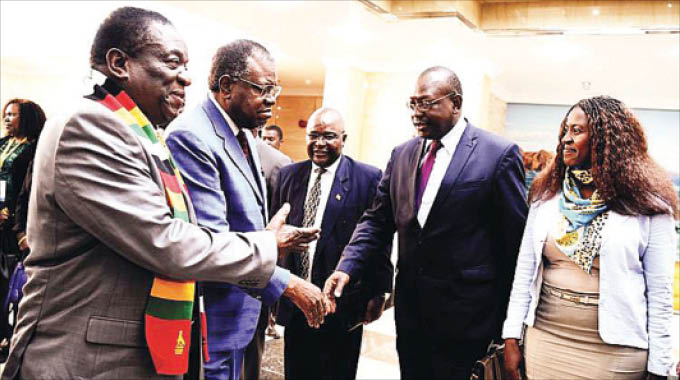EDITORIAL COMMENT: Zimbabwe-Namibia relations continue to grow

President Mnangagwa’s three-day State visit to Namibia ended yesterday, a tour of duty that consolidated the already solid bi-lateral relations between the two Sadc states.
Zimbabwe and Namibia have a lot in common. They are geographically connected – some argue almost geographically connected – by a speck of land running about 450 km from the northeast corner of the main block of Namibian territory eastward to the Zambezi River; a strand of land which is the Caprivi Strip. But even if geography does not emphatically connect both countries, there is no denying the soundness of their relationship.
They share a long liberation history, with Zimbabwe playing a prominent role in helping Namibia attain independence from apartheid South Africa in 1990. Also Namibian freedom fighters were close to ours in our own fight for independence. Having attained freedom 10 years earlier, the government of Zimbabwe was motivated to help a sister nation gain its freedom as her neighbours had done the same to her until 1980.
From that formidable foundation, Zimbabwe and Namibia have been one. They cooperate bilaterally in various fields and in terms of Sadc. For example, Zimbabwe has had a long history of assisting in the training of Namibians up to military and general security level. Namibia is one of the most favoured destinations for Zimbabweans seeking jobs abroad. Dozens of Zimbabweans are working in the Namibian civil service under some arrangements. The countries have co-operated in the energy sector as well.
President Mnangagwa’s visit this week further consolidated that vibrant Harare-Windhoek relationship.
He, together with his host, President Hage Geingob, witnessed the signing of seven agreements at the conclusion of the 9th Zimbabwe-Namibia Joint Permanent Commission on Cooperation (JPCC) on Thursday.
Some of the deals include a Memorandum of Understanding (MoU) on promotion of small to medium enterprises with particular focus on women; terms of reference on joint trade and economic cooperation; and a revised MoU on information and media.
In addition, the two countries agreed to cooperate in the area of science and technology development, while the Zimbabwe Revenue Authority (Zimra) and the Namibian Customs and Excise Department signed an agreement on mutual customs administrative assistance.
Zimra and the Namibian Customs and Excise Department also signed an agreement on practical implementation of bilateral trade agreements. Mashonaland West Province and Namibia’s Kavango eastern region agreed on a twinning arrangement.
Speaking after the signing ceremony, President Mnangagwa commended officials from both Zimbabwe and Namibia for successfully holding the JPCC. He said the signing of the agreements should lead into tangible programmes. He urged the public and private sectors of both countries to take full advantage of the agreements and explore investment opportunities and markets for their products.
“However, it is imperative that these agreements are timely and diligently implemented,” he said.
“The volume of trade and economic cooperation between the two countries must increase and there are vast prospects in this regard. Both public and private sector companies as well as small and medium enterprises must be encouraged to pursue markets in our respective countries. In Zimbabwe, opportunities exist in agriculture, mining, health infrastructure, manufacturing (and) tourism, among others.”
President Geingob expressed happiness at the healthy partnership between his country and Zimbabwe.
“Since independence in 1990, we have been consolidating bilateral ties,” he said.
“While noting the good progress made, we should place emphasis on our joint efforts to promote economic growth and sustainable development, it is imperative to ensure that agreements between our countries are timeously implemented. Namibia has benefited immensely from development assistance from the Government of Zimbabwe in a variety of fields and disciplines.”
We have no doubt that these agreements will be concretised. The record of the past 27 years since the JPCC was set up has been impressive thus the future can only be brighter.
Another important development from the President’s visit to Namibia is the agreement to elevate their co-operation to a bi-national commission (BNC). The previous framework ran at a ministerial level, but a BNC is chaired by the presidents of both countries. This means that decision making processes under the new framework are shortened and execution of agreements gets faster.
With the latest BNC, scheduled to meet for the first time in 2021, Zimbabwe now has three BNCs as it already has two with South Africa and Botswana. We are glad that co-operation between our countries and its neighbours continues to strengthen.
A third and equally important development from the President’s visit to Namibia is his official opening of Zimbabwe’s Dry Port Facility at Walvis Bay. Under construction for some time on a 19 000 square metre piece of land leased to Zimbabwe for 50 years, the facility provides a strategic and cheaper route for our country to the Atlantic Ocean. This establishes a more direct connection between local business and Namibia and markets further afield such as West Africa, Europe and South America. This also widens options for the country having relied for so long on sea ports in Mozambique and South Africa which are getting increasingly congested.










Comments